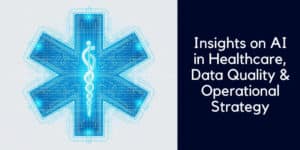What’s inside:
Get the lowdown on the benefits of AI and predictive analytics in healthcare inventory management in our latest blog, which tells you all you need to know:
- Challenge: Balancing cost control while ensuring crucial medical inventory is available for patient care is a constant struggle in hospitals.
- Solution: Predictive analytics powered by AI offers a powerful tool for healthcare providers.
- Benefits: This advanced healthcare technology forecasts future inventory needs with exceptional accuracy, optimizing stock levels and minimizing waste.
- Results: AI-driven inventory management leads to improved efficiency, reduced costs, and ultimately, enhanced patient care.
Striking a balance between cost control and stock availability is a constant struggle for healthcare providers. Predictive analytics technology has therefore emerged as a valuable tool, empowering healthcare providers with better forecasting information. This vital data can optimize demand planning, ensuring optimal stock levels and minimal waste. As a result, healthcare providers can improve efficiency while reducing costs.
Let’s dig a bit deeper on this topic to find out more.
Spreadsheets vs Predictive Analytics in Healthcare: Optimizing hospital inventory
Traditionally, hospitals relied on historical data stored in massive spreadsheets to predict future needs, but this is a time-consuming, hit-and-miss process that results in regular surpluses and stock-outs.
Enter predictive analytics, the technology that goes beyond number crunching. It leverages historical data, external demand drivers, seasonal trends, surgery schedule data and sophisticated algorithms, to accurately forecast future inventory needs.
Benefits of data-driven supply chain management
Gone are the days of relying on intuition for inventory management. Data-driven supply chains are revolutionizing the way hospitals manage their operations, leading to:
- Enhanced patient care: Predictive analytics in healthcare enables proactive inventory management, ensuring the right supplies are available for both scheduled and emergency surgeries. This translates to fewer delays and disruptions, improving patient care and reducing stress for medical staff.
- Reduced Waste and Stock-outs: By accurately forecasting demand and considering factors like upcoming surgeries, hospitals can minimize surpluses and prevent stock-outs. This eliminates the need for expensive rush orders and supports expiry management and waste reduction initiatives.
- Significant Cost Savings: Providers can achieve substantial cost savings by focusing funding on areas of identified need. Data-driven procurement typically results in a 10-30% inventory reduction in the first year, which lowers storage costs, minimizes waste, and results in far fewer last-minute deliveries.
By understanding demand and optimizing their inventory, healthcare organizations can work smarter.
Improved Efficiency, Enhanced Outcomes
The benefits of a well-oiled OR supply chain extend far beyond cost savings. Predictive analytics fosters:
- Reduced surgical delays: Streamlined inventory management minimizes delays caused by missing supplies and prevents cancellations.
- Improved communication: Data-driven insights can facilitate better communication between surgeons, nurses, and procurement teams, helping all parties to plan ahead using data they have confidence in.
- Enhanced patient care: A well-stocked OR translates to uninterrupted procedures and potentially better patient outcomes.
Challenges and Considerations
While powerful, implementing predictive analytics in healthcare in the OR isn’t without its challenges. Here are some things to consider:
- Data quality: The accuracy of predictions hinges on the quality and completeness of historical data. It’s vital to ensure data collection capabilities are robust so that analytics and insights are based on the full picture. Using new AI-vision supply utilization technology can bring OR data integrity up to 100%.
- Integration: Seamless integration with existing hospital information systems is crucial for efficient data flow. Data silos slow down data processing and impact accuracy. System interoperability facilitates smoother data analysis.
- Staff buy-in: Training and buy-in from OR staff are essential for successful implementation. Ensuring all OR data collection systems are user-friendly goes a long way towards achieving nurse compliance in perioperative documentation practices.
“Data is the currency of success in supply chain management, so implementing efficient data capture and analytical systems has become even more crucial to healthcare organizations.”
Shlomo Matityaho, CEO, IDENTI Medical

AI and Predictive Analytics Inventory Management Systems
AI is revolutionizing inventory management by utilizing predictive analytics to forecast demand with incredible accuracy. This not only reduces stock-outs and overstocking, but also minimizes storage and carrying costs.
By analyzing vast amounts of data at speed, AI automates reordering and streamlines inventory control, leading to a more efficient and cost-effective operation.
“As healthcare providers grapple with higher costs and tight margins, reducing supply chain costs via the use of AI and predictive analytics is the logical step forward.”
Shlomo Matityaho, CEO, IDENTI Medical
The Future of OR Supply Chain
Predictive analytics is rapidly transforming healthcare OR supply chains, helping to forecast real need based upon data patterns and trends that humans may miss. By embracing this predictive analytics technology, healthcare organizations can respond to changes in demand and better plan their future healthcare delivery.
Find out about the IDENTIPlatform, the AI managing software behind all our solutions, and which includes predictive analytics.
Book a chat with one of our Healthcare Solutions Experts to learn how AI and predictive analytics-powered solutions can .






